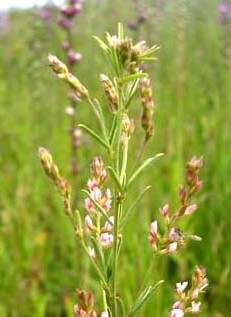Prairie lespedeza facts for kids
Quick facts for kids Prairie lespedeza |
|
|---|---|
 |
|
| Conservation status | |
| Scientific classification | |
| Genus: |
Lespedeza
|
| Species: |
leptostachya
|
| Synonyms | |
|
|
Lespedeza leptostachya is a special and rare flowering plant. It is part of the legume family, just like peas and beans! People often call it prairie lespedeza or prairie bush-clover. This plant grows in the Upper Midwest part of the United States. Its flowers are usually creamy-white to purplish. They grow in tall, narrow groups called spikes.
Contents
What is Prairie Bush-Clover Like?
Prairie bush-clover is a plant that lives for many years. It can grow up to about one meter (three feet) tall. Its leaves are covered in soft, whitish hairs. This makes the plant look a bit silvery. Each leaf has three smaller, long, thin parts called leaflets.
Flowers and Seeds
The plant's flowers grow in a spike at the top. They can be cream, yellowish, or light pink. Each flower is very tiny, only about half a centimeter long.
Interestingly, this plant has two kinds of flowers:
- Some flowers never open up. These are called cleistogamous flowers.
- Other flowers open wide. These are called chasmogamous flowers. Insects can visit these open flowers.
Both types of flowers can make seeds! This helps the plant reproduce. The plant usually blooms from July to September. It blooms the most in mid-July.
How it Grows
Prairie bush-clover takes a long time to grow up. It doesn't make flowers until it is 6 to 9 years old! After flowering, it produces a fruit called a legume pod. One plant can make over 500 pods. However, many of these pods might not have good seeds inside.
Where Does Prairie Bush-Clover Live?
This plant is found only in the Upper Midwest of the United States. It grows in states like Minnesota, Iowa, Wisconsin, and Illinois. Most of these plants are found in northern Iowa and southern Minnesota. It is quite rare across all these areas. Because it's so rare, the US government lists it as a threatened species.
Its Home: The Tallgrass Prairie
Prairie bush-clover loves to grow in tallgrass prairies. It especially likes dry spots. The soil there can be gravelly, sandy, or have lots of limestone. These soils usually drain water very well. The plant often prefers sloped areas that face north.
Many other plants grow alongside prairie bush-clover. Some common ones include:
- Big bluestem
- Little bluestem
- Yellow Indian grass
- Side-oats grama
- Prairie dropseed
- Porcupine grass
- Lead plant
- Rough blazing star
- Purple prairie clover
Sometimes, prairie bush-clover grows near a relative called Lespedeza capitata. These two plants can sometimes mix their genes. This creates a new plant that looks a bit like both parents. This is called a hybrid, but it doesn't happen very often.
Protecting Prairie Bush-Clover
There are only about 32 to 36 groups of prairie bush-clover left. These groups are spread out and most are small. Many have fewer than 150 plants. Sadly, many places where this plant used to grow no longer have it.
Why it's in Danger
The biggest problem for prairie bush-clover is losing its home. Much of the prairie land has been used for buildings or farms. Also, natural events like wildfires and grazing by animals like bison used to keep the prairie healthy. When these don't happen, shrubs start to grow too much. Prairie bush-clover doesn't do well when it has to compete with these woody shrubs. The plant likely needs some disturbance, like bison walking and eating, to thrive.
Other things that threaten the plant include:
- Quarry mining (digging for rocks)
- Herbicides (weed killers) and dirty water runoff
- Mowing
- Weeds that take over its space
Insects and small animals also eat the plants. Beetles can even get into the seed pods. Since the plant doesn't make seeds until it's at least six years old, and often self-fertilizes, there isn't much variety in its genes. This can make it harder for the plant to adapt to changes.
Helping the Plant
Scientists are working to help prairie bush-clover. They have planted it again in one area in Iowa. Since the plant probably did well with bison around, researchers are now letting cattle graze in one area. They want to see if this helps the plant grow better.


